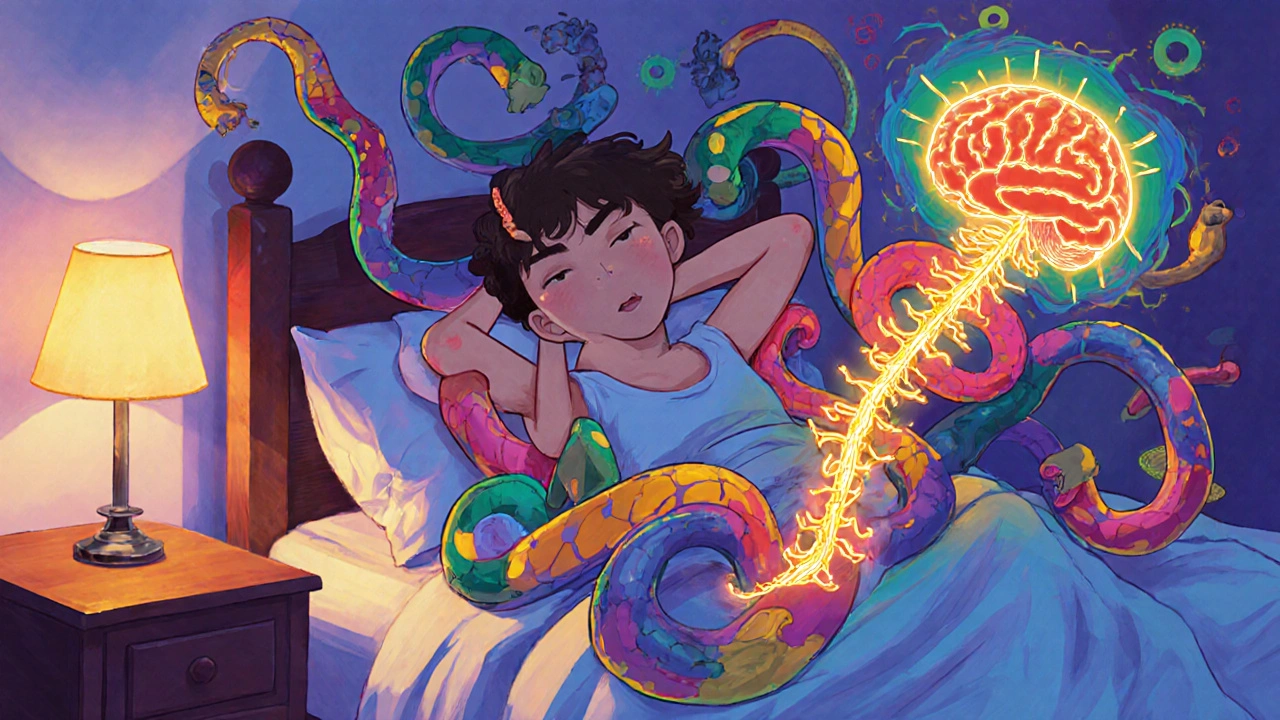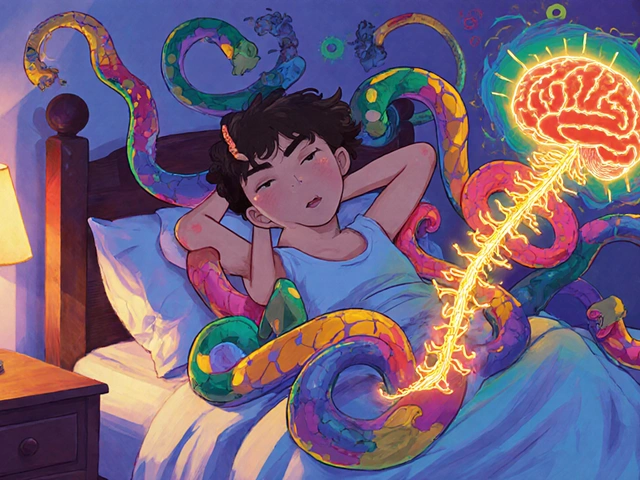For millions of people, waking up doesn’t mean feeling rested-it means feeling like they’ve been hit by a truck. That’s the reality for those with fibromyalgia: a constant, deep ache that doesn’t go away, no matter how much they sleep or rest. It’s not just muscle soreness. It’s pain that moves around, hits the shoulders, hips, knees, and neck, and comes with crushing fatigue, brain fog, and sleep so light you feel like you never left the surface. And here’s the hard truth: no blood test can prove it. No X-ray shows it. Doctors can’t point to a broken part. But the pain is real. And it’s been recognized by the American College of Rheumatology since 1990.
What Fibromyalgia Actually Is (And Isn’t)
Fibromyalgia isn’t arthritis. It’s not a muscle injury. It’s not in your head. It’s a disorder of how your nervous system processes pain. Your brain and spinal cord become hypersensitive. Normal sensations-like a light touch or the pressure of clothing-get amplified into pain signals. That’s why people with fibromyalgia often describe feeling tender all over, even when there’s no visible swelling or damage.
The official diagnosis requires pain lasting at least three months, affecting both sides of the body and above and below the waist, plus at least four other symptoms like fatigue, trouble sleeping, memory issues, or mood changes. It’s not about how many tender spots you have anymore-it’s about the full picture. And while it affects 2-8% of people worldwide, women make up 75-90% of diagnosed cases. Why? Scientists aren’t sure, but hormones, genetics, and how stress impacts the nervous system likely play roles.
One of the biggest myths? That fibromyalgia is just depression. It’s not. Yes, many people with fibromyalgia feel anxious or down-but that’s a reaction to living with constant pain, not the cause. In fact, antidepressants help not because they treat sadness. They help because they change how pain signals travel through the brain.
Why Antidepressants Are Used for Pain (Not Mood)
If you’ve been prescribed an antidepressant for fibromyalgia and you’re not depressed, you’re not alone. And you’re not being misdiagnosed. These medications work on pain pathways, not just mood.
Three drugs are FDA-approved specifically for fibromyalgia: duloxetine (Cymbalta), milnacipran (Savella), and pregabalin (Lyrica). Duloxetine and milnacipran are SNRIs-serotonin-norepinephrine reuptake inhibitors. They boost two brain chemicals that help shut down pain signals. Pregabalin, while not an antidepressant, works by calming overactive nerves in the spinal cord.
Then there’s amitriptyline, a tricyclic antidepressant. It’s not FDA-approved for fibromyalgia, but it’s one of the most commonly prescribed. Why? Because it helps with sleep, and sleep is the foundation of pain control. A 2022 review found that low doses of amitriptyline (10-50 mg at night) reduced pain by about 30% and improved sleep quality in 6-8 weeks.
But here’s what most doctors won’t tell you: these drugs work for about half the people who try them. StatPearls reports that only 50% of patients get meaningful pain relief from antidepressants. That means for every two people who take them, one won’t feel better. And for many, the side effects make it worse.
The Side Effects No One Talks About
Let’s be honest. Antidepressants for fibromyalgia come with a price tag you don’t see on the prescription label.
Duloxetine can cause nausea, dizziness, dry mouth, and increased anxiety-especially in the first few weeks. One patient on PatientsLikeMe said, “At 60 mg, I had panic attacks. I thought I was losing my mind.” That’s not rare. In a 2022 Health Union survey, 59% of people stopped duloxetine because of side effects.
Pregabalin? It causes dizziness in 30-40% of users and weight gain in 10-15%. Some people feel so groggy they can’t drive. And amitriptyline? Dry mouth, weight gain, blurred vision, and next-day grogginess are common. One woman on MyFibroTeam shared: “I took 25 mg for six months. I gained 18 pounds and felt like a zombie. But I slept for the first time in years. So I kept going.”
Discontinuation rates for antidepressants in fibromyalgia are 20-30%. That’s higher than for exercise or physical therapy, which have dropout rates of only 10-15%. So while these drugs can help, they’re not magic. They’re tools-and sometimes they’re heavy tools.

What Actually Works Better Than Pills
Here’s the most important thing you need to know: exercise is the most effective treatment for fibromyalgia.
That’s not a guess. It’s what the American College of Rheumatology says. And it’s backed by study after study. Low-intensity movement-like walking, tai chi, yoga, or Pilates-can reduce pain by 20-35% after just 6 months. Tai chi, in particular, improved pain by 20-30% in 12-week trials. Yoga cut pain intensity by 24% in a 2022 Arthritis Foundation study.
And it’s not just about pain. People who move regularly report better sleep, less brain fog, and more energy. The key? Start slow. Too much too soon triggers flare-ups. The rule of thumb: increase activity by no more than 10% per week. If you walk 10 minutes today, do 11 next week. Not 20.
Cognitive Behavioral Therapy (CBT) is another powerhouse. It doesn’t fix your pain, but it changes how you respond to it. Eight to twelve weekly sessions of CBT can reduce pain and disability by 20-30%. It teaches pacing, stress management, and how to break the cycle of fear → inactivity → more pain.
Acupuncture also helps. NHS data shows it reduces pain by 15-25% in 60% of people-but you need 6-12 weekly sessions. It’s not a quick fix. It’s a commitment.
How to Actually Use Antidepressants (Without Getting Hurt)
If your doctor recommends an antidepressant, here’s how to do it right:
- Start low. Amitriptyline? Begin at 5 mg at night. Duloxetine? Start at 30 mg-not 60. Most side effects happen when people jump to full doses too fast.
- Go slow. Increase the dose by 5-10 mg every week or two. Give your body time to adjust.
- Take it at night. Most of these meds cause drowsiness. Taking them before bed helps with sleep and reduces daytime grogginess.
- Track your symptoms. Keep a simple log: pain level (1-10), sleep quality, side effects. This helps you and your doctor decide if it’s working.
- Don’t quit cold turkey. Stopping suddenly can cause withdrawal-dizziness, nausea, brain zaps. Always taper down with your doctor’s help.
And here’s the golden rule: combine meds with movement. A 2022 Arthritis Foundation survey found that 37% of people who got the best results used low-dose antidepressants and did tai chi or yoga at least three times a week. The pills helped with the immediate pain. The movement helped them stay functional long-term.

What’s New in 2025
The field is changing. In February 2024, the FDA accepted a new drug application for centanafadine (XRS-001), which showed 35% pain reduction in late-stage trials-with fewer side effects than current options. It could be available by late 2025.
Also, the NIH has poured $15 million into research on central sensitization-the brain’s role in turning up pain signals. They’re looking at brain imaging, inflammation markers, and even non-invasive brain stimulation devices like the FDA-cleared Quell device, which uses nerve stimulation to block pain.
And the biggest shift? Fibromyalgia is no longer seen as a “psychological” condition. It’s recognized as a neurological disorder. That’s why insurance coverage for physical therapy and CBT is slowly improving-even though only 35% of plans still cover it.
What to Do If You’re Struggling
If you’ve tried antidepressants and they didn’t work-or they made you feel worse-you’re not broken. You just haven’t found your plan yet.
Start here:
- Find a physical therapist who understands fibromyalgia. They’ll teach you how to move without triggering flares.
- Try a free 10-minute yoga video on YouTube designed for chronic pain. Do it three times this week.
- Download the CDC’s free “Managing Fibromyalgia” online course. It’s practical, no-fluff, and takes less than an hour.
- Join r/fibromyalgia on Reddit. Read the October 2023 survey results. You’re not alone.
And if your doctor pushes pills before movement? Ask: “What’s the evidence for this drug in my case? What are the side effects? What happens if I try exercise first?”
Fibromyalgia isn’t a life sentence. It’s a puzzle. And the best solutions aren’t in a pill bottle-they’re in your body, your routine, and your persistence.
Can antidepressants cure fibromyalgia?
No. There is no cure for fibromyalgia. Antidepressants help manage symptoms-mainly pain and sleep-but they don’t fix the underlying nervous system sensitivity. They’re a tool, not a solution.
Why do doctors prescribe antidepressants if I’m not depressed?
They’re not prescribing them for depression. They’re using them because these drugs affect serotonin and norepinephrine-brain chemicals that also control pain signals. It’s a side effect turned into a treatment.
Which antidepressant is best for fibromyalgia?
There’s no single “best.” Duloxetine and milnacipran (SNRIs) are FDA-approved and help about 50% of people. Amitriptyline (a TCA) is cheaper and helps with sleep but causes more side effects. The best one is the one you can tolerate and that gives you more benefit than discomfort.
How long does it take for antidepressants to work for fibromyalgia?
It varies. Amitriptyline often improves sleep in 2-4 weeks. SNRIs like duloxetine may take 4-6 weeks to reduce pain. Don’t expect instant results. Give it at least 6-8 weeks before deciding if it’s working.
Can I stop taking antidepressants if I start exercising?
Maybe-but don’t quit on your own. Many people reduce or stop meds after building a consistent exercise and CBT routine. But you need to do it slowly, with your doctor’s help. Stopping suddenly can cause withdrawal symptoms.
What if antidepressants make my pain worse?
Talk to your doctor immediately. Some people experience increased anxiety, dizziness, or even pain spikes. That doesn’t mean you’re “failing”-it means that medication isn’t right for you. There are other options: physical therapy, tai chi, acupuncture, or a different drug.

